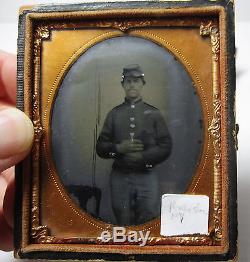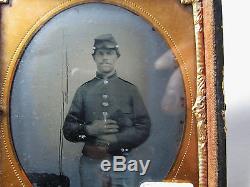Tintype Photo Civil War Soldier Cased Image Ambrotype 1860s Rochester NY



Civil War Soldier Encased Image Rochester, New York. Please see my listings for MORE Soldiers.
For offer, an interesting photo! Fresh from a prominent estate in Upstate NY.
Never offered on the market until now. Vintage, Old, Original, Antique, NOT a Reproduction - Guaranteed!! This Union soldier in uniform holds book - probably a Bible. Came from a Rochester, NY estate with other images.
With case, measures 3 5/8 x 3 1/8 inches. In good condition - case has leather gone on left side edge. Image is not crystal clear, as shown in photos. Pleas e see photos for details. If you collect 19th century Americana history, American military photography, Monroe County, etc.This is a treasure you will not see again! Add this to your image or paper / ephemera collection. Perhaps genealogy research importance too. The American Civil War, widely known in the United States as simply the Civil War as well as other sectional names, was a civil war fought from 1861 to 1865 to determine the survival of the Union or independence for the Confederacy.
Among the 34 states as of January 1861, seven Southern slave states individually declared their secession from the United States and formed the Confederate States of America, known as the "Confederacy" or the "South". They grew to include eleven states, and although they claimed thirteen states and additional western territories, the Confederacy was never diplomatically recognized by a foreign country. The states that remained loyal and did not declare secession were known as the "Union" or the "North". The war had its origin in the fractious issue of slavery, especially the extension of slavery into the western territories.
[N 1] After four years of combat that left over 600,000 Union and Confederate soldiers dead and destroyed much of the South's infrastructure, the Confederacy collapsed and slavery was abolished. Then began the Reconstruction and the processes of restoring national unity and guaranteeing civil rights to the freed slaves. In the 1860 presidential election, Republicans, led by Abraham Lincoln, opposed the expansion of slavery into US territories. The Republican Party, dominant in the North, secured a majority of the electoral votes, and Lincoln was elected president, but before his inauguration on March 4, 1861, seven slave states with cotton-based economies formed the Confederacy. The first six to secede had the highest proportions of slaves in their populations, a total of 48.8% for the six.
[5] Outgoing Democratic President James Buchanan and the incoming Republicans rejected secession as illegal. Lincoln's inaugural address declared his administration would not initiate civil war. Eight remaining slave states continued to reject calls for secession. Confederate forces seized numerous federal forts within territory claimed by the Confederacy.
A peace conference failed to find a compromise, and both sides prepared for war. The Confederates assumed that European countries were so dependent on "King Cotton" that they would intervene; none did and none recognized the new Confederate States of America. Hostilities began on April 12, 1861, when Confederate forces fired upon Fort Sumter, a key fort held by Union troops in South Carolina. Lincoln called for every state to provide troops to retake the fort; consequently, four more slave states joined the Confederacy, bringing their total to eleven.Lincoln soon controlled the border states, after arresting state legislators and suspending habeas corpus, [6] ignoring the ruling of the Supreme Court's Chief Justice that such suspension was unconstitutional, and established a naval blockade that crippled the southern economy. The Eastern Theater was inconclusive in 186162. The autumn 1862 Confederate campaign into Maryland (a Union state) ended with Confederate retreat at the Battle of Antietam, dissuading British intervention. [7] To the west, by summer 1862 the Union destroyed the Confederate river navy, then much of their western armies, and the Union siege of Vicksburg split the Confederacy in two at the Mississippi River. Lee's Confederate incursion north ended at the Battle of Gettysburg.
Lincoln issued the Emancipation Proclamation, which made ending slavery a war goal. [8] Western successes led to Ulysses S.
Grant's command of all Union armies in 1864. In the Western Theater, William T.
Sherman drove east to capture Atlanta and marched to the sea, destroying Confederate infrastructure along the way. The Union marshaled the resources and manpower to attack the Confederacy from all directions, leading to the protracted Siege of Petersburg. The besieged Confederate army eventually abandoned Richmond, seeking to regroup at Appomattox Court House, though there they found themselves surrounded by union forces. This led to Lee's surrender to Grant on April 9, 1865. All Confederate generals surrendered by that summer. The American Civil War was one of the earliest true industrial wars.Railroads, the telegraph, steamships, and mass-produced weapons were employed extensively. The mobilization of civilian factories, mines, shipyards, banks, transportation and food supplies all foreshadowed World War I. It remains the deadliest war in American history, resulting in the deaths of an estimated 750,000 soldiers and an undetermined number of civilian casualties. [N 2] One estimate of the death toll is that ten percent of all Northern males 2045 years old, and 30 percent of all Southern white males aged 1840 died.
[10] From 1861 to 1865 about 620,000 soldiers lost their lives. The item "Tintype Photo Civil War Soldier Cased Image Ambrotype 1860s Rochester NY" is in sale since Wednesday, April 01, 2015. This item is in the category "Collectibles\Militaria\Civil War (1861-65)\Original Period Items\Photographs".
The seller is "dalebooks" and is located in Rochester, New York. This item can be shipped worldwide.
- Country/Region of Manufacture: United States

